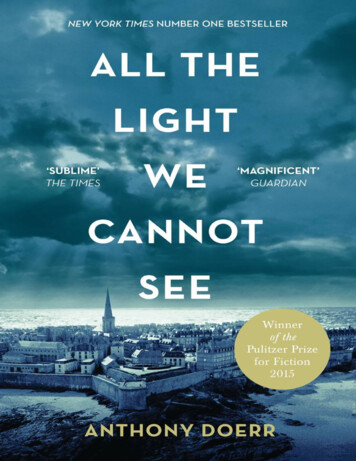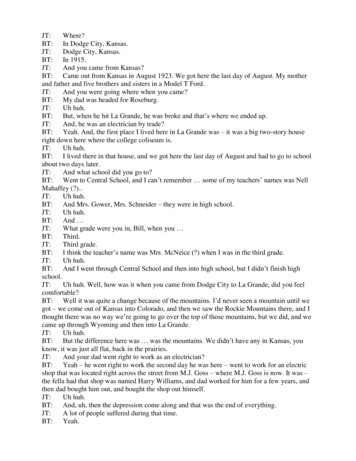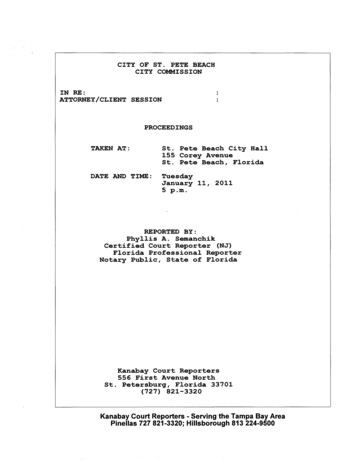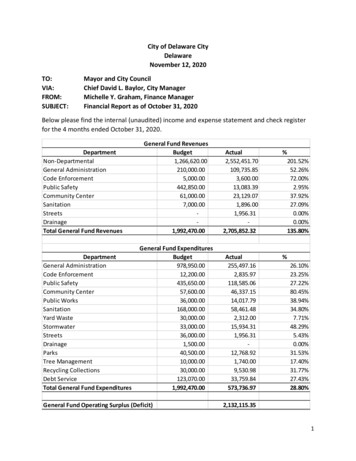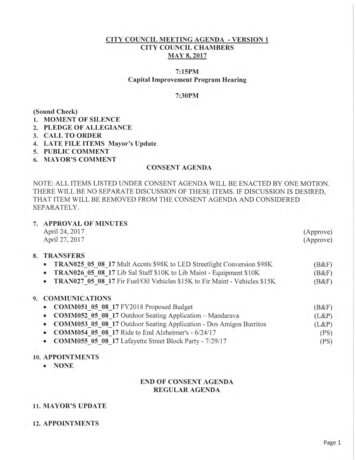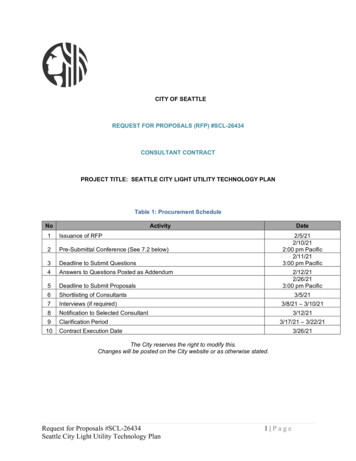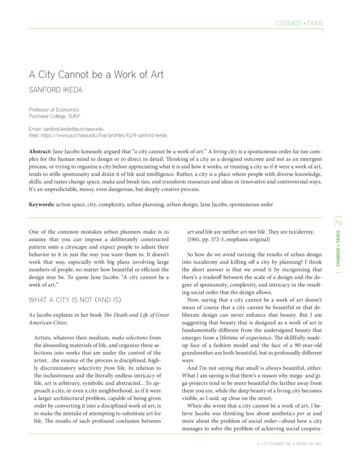
Transcription
COSMOS TAXISA City Cannot be a Work of ArtSANFORD IKEDAProfessor of EconomicsPurchase College, SUNYEmail: sanford.ikeda@purchase.eduWeb: -ikedaAbstract: Jane Jacobs famously argued that “a city cannot be a work of art.” A living city is a spontaneous order far too complex for the human mind to design or to direct in detail. Thinking of a city as a designed outcome and not as an emergentprocess, or trying to organize a city before appreciating what it is and how it works, or treating a city as if it were a work of art,tends to stifle spontaneity and drain it of life and intelligence. Rather, a city is a place where people with diverse knowledge,skills, and tastes change space, make and break ties, and transform resources and ideas in innovative and controversial ways.It’s an unpredictable, messy, even dangerous, but deeply creative process.Keywords: action space, city, complexity, urban planning, urban design, Jane Jacobs, spontaneous orderWHAT A CITY IS NOT (AND IS)As Jacobs explains in her book The Death and Life of GreatAmerican Cities:Artists, whatever their medium, make selections fromthe abounding materials of life, and organize these selections into works that are under the control of theartist the essence of the process is disciplined, highly discriminatory selectivity from life. In relation tothe inclusiveness and the literally endless intricacy oflife, art is arbitrary, symbolic and abstracted To approach a city, or even a city neighborhood, as if it werea larger architectural problem, capable of being givenorder by converting it into a disciplined work of art, isto make the mistake of attempting to substitute art forlife. The results of such profound confusion betweenart and life are neither art nor life. They are taxidermy.(1961, pp. 372-3, emphasis original)So how do we avoid turning the results of urban designinto taxidermy and killing off a city by planning? I thinkthe short answer is that we avoid it by recognizing thatthere’s a tradeoff between the scale of a design and the degree of spontaneity, complexity, and intricacy in the resulting social order that the design allows.Now, saying that a city cannot be a work of art doesn’tmean of course that a city cannot be beautiful or that deliberate design can never enhance that beauty. But I amsuggesting that beauty that is designed as a work of art isfundamentally different from the undersigned beauty thatemerges from a lifetime of experience. The skillfully madeup face of a fashion model and the face of a 90-year-oldgrandmother are both beautiful, but in profoundly differentways.And I’m not saying that small is always beautiful, either.What I am saying is that there’s a reason why mega- and giga-projects tend to be more beautiful the farther away fromthem you are, while the deep beauty of a living city becomesvisible, as I said, up close on the street.When she wrote that a city cannot be a work of art, I believe Jacobs was thinking less about aesthetics per se andmore about the problem of social order—about how a citymanages to solve the problem of achieving social cooperaA City Cannot be a Work of Art79COSMOS TAXISOne of the common mistakes urban planners make is toassume that you can impose a deliberately constructedpattern onto a cityscape and expect people to adjust theirbehavior to it in just the way you want them to. It doesn’twork that way, especially with big plans involving largenumbers of people, no matter how beautiful or efficient thedesign may be. To quote Jane Jacobs: “A city cannot be awork of art.”
80COSMOS TAXIStion among thousands and millions of strangers. And forthe same reason she didn’t think that a city could be a workof engineering. Both the engineering perspective and theaesthetic perspective abstract from an organic whole; bothsubstitute the vision of a single mind for the intricacies of asystem that is the result of many minds. These reasons parallel those of F.A. Hayek (1967) who warned of the dangersof conflating planned orders for unplanned or “spontaneous orders.”The economist Richard E. Wagner (2010) draws the samedistinction in his contrast between “piazza and parade.”In a parade, each person follows an explicit, pre-assignedset of commands consciously constructed by some kindof overall planner. While any social framework constrainsindividual choice to some degree, a parade, on the streetor especially on an American football field, is perhaps themost extreme example of this. To achieve the pre-ordainedpattern, no marcher can deviate from her assigned movements and her individuality must be submerged into thecollective. Individual choice in this context, aside perhapsfrom the choice of the marcher to join the parade in the firstplace, must be ruled out. Individuality, the freedom to deviate from one’s role in the collective, would spell disasterand therefore it can’t be tolerated. The relations among themarchers have to be formal and narrowly constrained.People of course also relate to one another in a piazza.Whether sitting, standing, or walking (or dancing), thereare rules each person needs to follow in order to preserveorder. But those rules are typically informal, tacit, andnegative in the sense that they tell you what you cannot dorather than what you can do. Perhaps you’re not allowed totoss trash into the fountain or play loud music or assaultpassersby. Anything else not forbidden—bathing in thefountain or singing to soft music or talking to strangers orwhatever—is allowed. The scope of what you can do in thishypothetical piazza is infinitely broader than what you cannot do, indeed must do, in a parade (e.g. take five steps forward, turn 90-degrees to the right, and so on).Let me define this kind of piazza-order, a spontaneousorder asa stable set of relations among individuals that emerges unplanned from their collective interactions andthat is sufficiently coherent to enable them to formand carry out their plans with a reasonable expectation of success.VOLUME 4 ISSUE 2 3 2017It is in this sense that Hayek refers to a spontaneous orderas “the result of human action but not of human design.”The people whose actions constitute the order may or maynot be aware that their choices contribute to the pattern,but they certainly do not know precisely how their choicesdo so. Examples of spontaneous orders include language,culture, legal interpretation, market prices. Quite a wideranging list!In fact, because of the central role of cities in the development of so many spontaneous social orders, I believe weshould view a living city as a spontaneous order par excellence. The city is a social order that breeds and sustains themost important, spontaneously generated social orders thatconstitute civil society.That’s why Jacobs was so harshly critical of highly centralized, heavy-handed post-World War II-style urban planning, in which planners worked to transform messy piazzasinto pretty parades. Indeed, her criticism was basically thatthe planners of her day were typically unaware of the essential difference between the two. They tried to substitutetheir vision of the ideal city—clean, segregated, geometric,large-scale—onto patterns of social interaction and orderthey did not see or understand or care about. They werefor the most part committed to what they believed was thecommon-sense goal of restoring efficiency to the unplannedcity and didn’t mind being bold or brutal. For examples weneed look no further than to Brasilia or more recently toChina’s ghost cities.She was no less critical of contemporary urban theory.The paradigm is Louis Wirth’s (1938, p. 18) model of a cityas a 3-variable problem—population, density of settlement,and degree of heterogeneity—with which he argued it waspossible to “explain the characteristics of urban life and toaccount for the differences between cities of various sizesand types.” In contrast, Jacobs saw a living city as a problem of “organized complexity,” which involves “dealingsimultaneously with a sizable number of factors which areinterrelated into an organic whole” (1961, p. 432); that is, aspontaneous order.Much more congenial to her way of thinking were the design theories of Kevin Lynch (1960) or William H. Whyte(1980) or Jan Gehl (2013). She might have been very sympathetic to the traffic philosophy of “shared space” that isspreading across Northern Europe today. They each paycareful attention to what real people do and how they interact with one other and with the built environment. Eachto some degree understood with Jacobs that a living city is aspontaneous order.
COSMOS TAXISWhat the Tradeoffs AreFirst of all, Jacobs observed that the artist abstracts fromlife, with all its “inclusiveness” and “literally endless intricacy.” Many architects, especially those with great ambition, seem to treat urban environments as a mere canvas fortheir personal creations; a canvas which if not already blankhas to be wiped clean before they can get to work. The goodarchitects at least try to take into account how their constructions fit or don’t fit into the existing built environmentand how real people might actually use them. But whetheryou’re an architect—or an economist—predicting how people will respond to a change is a pretty iffy thing. From myperspective that iffiness comes from two factors: complexityand radical ignorance.Complexity in this context means that the interactionsamong people are so numerous or varied or changeable thatthe costs of being aware of all of them is too high for anyone to calculate. Hayek defines the “degree of complexity”in terms of the “minimum number of elements of which aninstance of the pattern consists in order to exhibit all thecharacteristic attributes of the class of patterns in question ” (Hayek 1964). In a world with only a few variables,such as those described in a high-school algebra problem,it is possible to have all the knowledge you need to get thecorrect answer. In the real world, however, the number ofrelevant variables is too large; that is, the number of everchanging interactions among people in society is so large,and our cognitive powers are too limited, to find a “solution.” Indeed, compared to the vast complexity of the socialorder, predicting this week’s weather is a pretty simple matter.Radical ignorance means being unaware of informationthat would be relevant to making a decision, not becausethe cost is too high, but because we are unaware that therelevant information even exists. For example, you mightbe very hungry but walk blithely by Restaurant X, whichserves food that would satisfy your hunger. A simple solution escapes your notice because of your lack of alertness.So whether the problem is complex or relatively simple, notknowing that you do not know means you cannot solve theproblem because in some sense you are unaware that theproblem even exists.Acting in the presence of complexity and radical ignorance means that it is impossible to trace all the consequences of your action because (1) you are not even aware ofat least some of the consequences and (2) the ramificationsof your action are too numerous or subtle to follow givenyour limited mental capabilities even if you were in factaware of them. So as a rule the bigger the scale of the changes you wish to make in the real world, or the more detailedthe design you wish to impose on a given scale of activity,the harder it will be to predict what is going to happen.One of the lessons economists learned from the 20th century debate over collectivist central planning—the so-called“socialist calculation debate”—is that the “optimal” level ofcentral planning is a lot lower than most of us think. The local knowledge that makes things work is inherently beyondthe grasp of the central planner and accounting for incentives is problematic. And the more someone tries to designa social order, the more people will strive to adjust to herinterventions in unforeseen ways, thwarting her intentions.In the context of urban design, that means that substitutingthe genius of the planner for the collective genius of ordinary people diminishes the intricacy, complexity, and yesthe deep beauty of the resulting social order, and generatesnegative unintended consequences.The larger and more elaborate a design is in relation tothe social space it’s trying to fit into, the narrower will bethe scope of unplanned activities that it can permit. That’sbecause a structure, of any scale and degree of design, necessarily constrains to some extent how people will use it andthe space around it. Building a mid-size townhouse withina commercial block changes the character of the rest of thatblock and perhaps also the surrounding neighborhood. Thebigger the structure, the bigger the change will be.In addition, constructing something that takes up an entire city block, like the Empire State Building, not only limits what people can do in and around that space but it alsochallenges the designer to try to account for the way peoplewill want to use it. Scaling up to something like LincolnCenter or Hudson Yards exponentially increases the difficulty of predicting people’s behavior in and around thatspace and of constraining how they actually will use it. Ifshe wants to preserve the potential for unplanned liveliness,the designer will need to leave substantial room for adjustment over time, otherwise the level of social complexity willbe limited by her imagination at a single point in time.A city can handle endless waves of complex, on-goingproblems if the rules that govern interaction, and the spaceswithin which people interact, allow many minds to discoverthose problems and to work on them over time. Good urban design therefore needs to take seriously into account acity’s “invisible infrastructure”—i.e. the patterns of contact,use, and ever-changing social networks that promote orderA City Cannot be a Work of Art81COSMOS TAXISNow, what about those tradeoffs?
and social
toss trash into the fountain or play loud music or assault passersby. Anything else not forbidden—bathing in the fountain or singing to soft music or talking to strangers or whatever—is allowed. The scope of what you can do in this hypothetical piazza is infinitely broader than what you can-not do, indeed must do, in a parade (e.g. take five steps for- ward, turn 90-degrees to the right .


